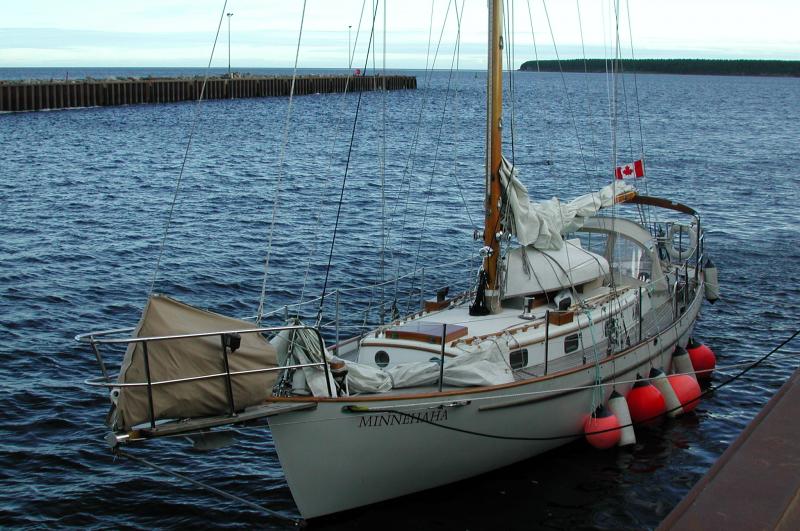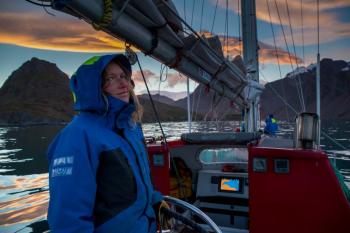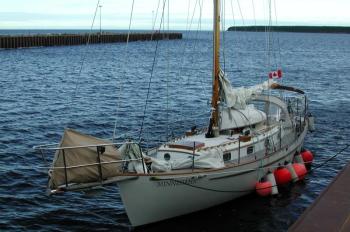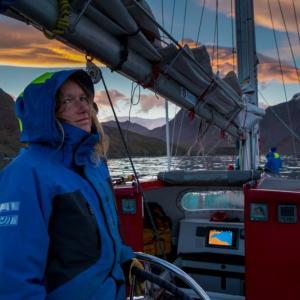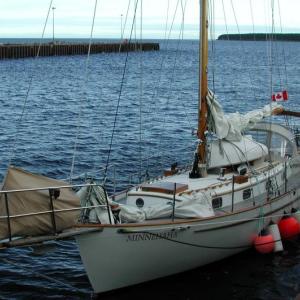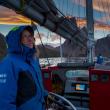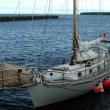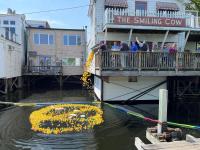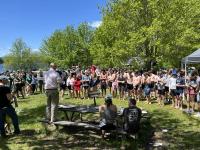Despite pandemic’s hinderance, Kirsten Neuschafer remains eager for solo-sail Golden Globe Race
When Kirsten Neuschafer last spoke with the Penobscot Bay Pilot, in mid-March, COVID-19 had just made its way to Maine. It was a time when many believed the brunt of the pandemic would have been contained within a month and area students would be back in the classroom by the conclusion of April break.
Neuschafer, for her part, was beginning her preparations to be the only female competing in the 2022 Golden Globe Race that includes 35 sailors circumventing the globe, 30,000 miles nonstop, starting in France, with no outside assistance and no modern technology.
A year ago, Neuschafer found herself on Pelagic sailing into Maine and was able to spend most of last summer in the Midcoast, working on the Pelagic’s refit at the Lyman-Morse boatyard.
“I really got to enjoy the place and the people — a remarkably ‘nautical’ community,” she commented, in March. “I am quite excited to be back in Maine again [...] recommissioning Pelagic for upcoming trips! The local community has welcomed me from my first day here.”
When the last edition of the Golden Globe Race was held, in 2018, the South African native was inspired by the event, which is a retro-style race, based on an older design with low-tech boats. The boats cannot have modern electronic equipment, meaning sailors rely on traditional, celestial navigation.
“This, to me, takes sailing back to its purest essence,” Neuschafer said. “The fact that it is a solo, non-stop, unassisted circumnavigation makes this race immensely challenging, but gives it a very interesting dynamic — where you not only need to know how to make your boat move as fast as possible, but you need to be very observant of the elements (as opposed to getting modern forecasting).”
Endurance and the ability to persist are keys for a sailor’s success during this race, she said.
“You will need to be resourceful, to solve problems with only your own two hands,” she said. “And it has the added elements of attrition and luck (which other races have to a much lesser degree), giving it that enormous element of adventure.”
Ultimately, this race is perfect for Neuschafer, as she put it, during a March interview.
“I love single-handed sailing — and solo adventures — so, it really is just my cup of tea,” she commented. “I thought back then already, if I got a chance to enter, I would not need to think twice.”
To prepare for the race, there are a variety of deadlines laid out by event organizers Neuschafer must meet over the next two years.
First was to secure a boat.
Neuschafer purchased a Cape George 36 that was built in Port Townsend, Washington. The boat currently is in Newfoundland, meaning the next step will be to collect the boat from Canada.
But that is where to her dilemma spurred by the pandemic begins — her boat, months later, remains stranded in Newfoundland.
The pandemic has shuttered the US-Canadian border to non-essential travel leaving without access to her boat.
“The pandemic has, in principal stopped me from getting to my boat sooner and starting to sail it, before launching into a substantial refit,” Neuschafer said in a late August interview. “Of course, the more time I have, the better I can prepare, so every week and month that I lose is precious to me.”
Every month the border remains closed — it is presently — slated to remain closed until Sept. 21, means less time for Neuschafer to sail or work on the boat with winter approaching.
“[W]ith my boat being in Newfoundland, sailing and or working in winter months will be impossible, unless I can get my boat into a heated shed before then,” she said. “If it had not been for the pandemic and the border closure, I might well have spent most of my summer working on and sailing my boat.”
Conforming to the requirements of the race, the boat is not longer than 36 feet, sporting a long keel with a rudder attached to the trailing edge of the keel, the design predates 1988, and more than 20 of these boats have been built out of one mold.
“I was looking for a particularly seaworthy boat, but also one that is reputedly fast, for this era and style of design — something that could be competitive to the GGR 2018’s winning Rustler 36, and I believe the Cape George 36 is the ideal boat for me,” she said.
The boat is 31 feet in length on the waterline and 10.5 feet on the beam, with a displacement of 23,300 pounds and sail area of 806 square feet with a ballast/displacement ratio of 45.06.
“A good ballast displacement ratio is really important for a race of which more than two thirds takes place in the Southern Ocean, as we know, high winds and high sea-state down there are inevitable, and there were a fair few capsizings down there in the GGR 2018,” said Neuschafer. “So, I need a boat that is really, really up for those conditions.”
There is another important reason this boat is ideal for the race.
“The other quality of the Cape George 36 is that it is reputed to track extremely well, which means, with a balanced sail-trim, it can hold its course well, and as the only permitted self-steering is a wind-vane, this will make the wind-vane’s job a lot easier, meaning less strain and wear on the gear,” Neuschafer said. “This was a problem for some of the boats in GGR 2018/19: breakage to self-steering gear, which in some cases even meant giving up the race – so this is quite a key factor. On a whole, this Cape George 36 is a serious, blue-water vessel, and I am thrilled to have it for the race.”
The boat will need to recommissioned and refitted, the latter set to be extensive with an entire new rig, adding reinforcements, water-tight bulkhead and companionway.
Neuschafer knows she will need to inspect every bit of the boat, replacing or repairing any worn parts or components — another aspect of preparation hindered by the pandemic.
Following the refit, she will need to complete a 2,000 nautical-mile qualifier on the boat using only celestial navigation and wind-vane.
“This will be a good time to get to know the boat’s sea-going qualities: for getting speed out of her, and for mastering best storm-tactics,” Neuschafer said, in March. “And I need to work into my calendar — before or after the 2000nm qualifier — to participate in a few double-handed races, to train (and perhaps get coaching) for speed and for racing. After the qualifier, I hope to have time to still do final modifications and adjustments to the boat, and then the boat still needs to be sailed across the pond for the start in France.”
At this point, Neuschafer simply wants to access her boat in Newfoundland.
“Primarily, I need to get to my boat,” she said. “I will no longer have any time to do much sailing and familiarizing myself with the boat, but if I can still get it launched and moved to a suitable workspace, then at least I can spend all the winter months working on it. That way I could launch the boat in the spring again and start seriously sailing and training on it.”
With the border closures being extended continuously, there is uncertainty when Neuschafer will be able to get her boat.
“My preparation plans are very much dependent on the borders opening: if I can get to Canada, then I would be spending my last months and beyond on working on the refit of my boat,” she said. “However, if I cannot get to Canada in time, I might well need to go back home to South Africa for a few months — and then, at best, I can continue with the planning and the logistical side of things, as well as my ongoing fund-raising efforts — and other than that, just do as much sailing as possible — even if this would not be on my own boat — and concentrate on staying and getting as fit as possible.”
While awaiting the reopening of the border, Neuschafer has been staying fit and motivated, practicing celestial navigation, networking, and refining her budget as the pandemic has posed financial constraints on her preparation.
“For one, I have not had the work I was expecting to have this summer, and other than that, it has become difficult to approach corporate sponsors,” she said. “With the focus on somehow getting through the pandemic and funds predominantly going towards mitigating the effects of the pandemic on the economy, it might be reasonable to say that round-the-world sailing races projected to happen in two years' time, are not top priority right now.”
Event Date
Address
United States


